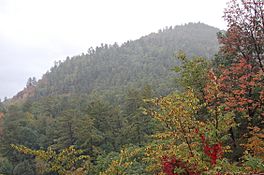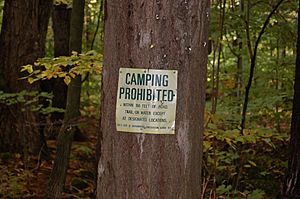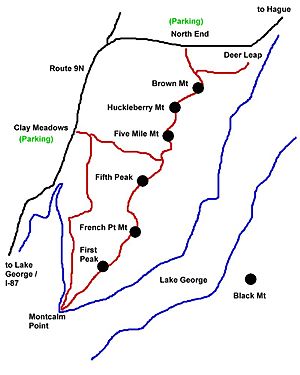Tongue Mountain Range Trails facts for kids
Quick facts for kids Tongue Mountain Range Trails |
|
|---|---|

Five Mile Mountain summit
|
|
| Length | 25 mi (40 km) |
| Location | Warren County, New York, USA |
| Trailheads | Various |
| Use | Hiking |
| Elevation change | 1,258 ft (383 m) |
| Highest point | Five Mile Mountain, 2,258 ft (688 m) |
| Difficulty | Easy to strenuous |
| Season | Easiest late May to mid-October |
| Hazards | Severe weather, timber rattlesnakes |
The Tongue Mountain Range Trails are a group of exciting hiking paths. They are found in the Tongue Mountain Range, which is part of the amazing Adirondack Mountains in New York. These trails are about 25 miles (40 km) long in total. They offer something for everyone, from easy walks near Lake George to tougher climbs up mountain peaks.
Contents
Exploring the Tongue Mountain Trails
The Tongue Mountain Range has six main peaks along its ridge. These include First Peak, French Point Peak, Fifth Peak, Five Mile Mountain, Huckleberry Mountain, and Brown Mountain. Five Mile Mountain is the highest point in the Town of Bolton.
One popular path, the Five Mile Mountain trail, takes you past Five Mile Mountain, Huckleberry Mountain, and Brown Mountain. As you hike, you'll go through both wooded areas and open, rocky spots. The trail climbs about 1,258 feet (383 m) from its lowest to highest points.
You can find special shelters called lean-tos for camping overnight at Fifth Peak and Brown Mountain. Other trails, starting from Clay Meadow, explore the southern part of the range. These include First Peak, French Point Peak, and Fifth Peak.
Amazing Views from the Trails
From the trails, you can see incredible sights! You'll get wide views of the Adirondacks, the huge Lake Champlain, and even the Green Mountains in Vermont. It's a great way to see the beauty of nature.
Important Rules for Hikers
Camping and making fires are allowed along the Tongue Range Trails. However, you must only do so in areas approved by the New York Department of Environmental Conservation. There are specific rules to follow to keep everyone safe and protect the environment.
It's very important to follow "leave no trace" guidelines. This means you should pack out everything you pack in, stay on marked trails, and leave nature just as you found it. Camping and fires are not allowed above 4,000 feet (1,219 m) elevation.
How the Mountains Were Formed
The Tongue Mountain Range is made of a type of rock called quartz-bearing syenite. This rock is very old! The range stretches about 10 miles (16 km) south into Lake George.
Long, long ago, the Tongue Mountain used to separate two ancient rivers. These rivers flowed before the modern Lake George was even formed. It's cool to think about how the land has changed over millions of years!
Nature's Classroom: Plants and Animals
This area is a protected wildlife preserve. This means it's a special place where animals and plants are kept safe. You'll find many different kinds of trees, plants, and animals here.
Experts have found lots of different plants along the trails. There are fifteen types of trees, sixteen kinds of ferns, and over sixty types of herbs! The rocky areas are covered with mosses and lichens, which are tiny, tough plants. These rocky spots are very delicate habitats, so be careful where you step.
Meet the Timber Rattlesnakes
The Tongue Mountain area is also home to timber rattlesnakes. These are large snakes, some growing up to 5 feet (1.5 m) long. They like to hide in the wooded areas. They also enjoy warming up by basking in the sun on exposed rocks. If you see one, give it space and do not disturb it.
Many birds live in or visit the area. You might see different kinds of waterfowl near the water. You could also spot amazing birds like Peregrine Falcons flying overhead.
Long ago, in the 1800s, people used to cut down many trees here for timber. About half of the forest was cut down. The wood was used for sawmills and iron factories. Today, the forest is recovering and protected.
Gallery













